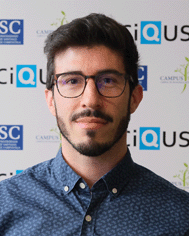Horizons Community Board collection: antimicrobial materials and surfaces
Ignacio
Insua
 *a and
Ignacio
Martín-Fabiani
*a and
Ignacio
Martín-Fabiani
 *b
*b
aUniversidade de Santiago de Compostela, Spain. E-mail: ignacio.insua.lopez@usc.es
bLoughborough University, UK. E-mail: i.martin-fabiani@lboro.ac.uk
Materials Horizons and Nanoscale Horizons set up their Community Boards several years ago, aiming to support early career researchers so that they could share their experiences and ideas on scientific publishing. As future leaders in their respective fields, the Community Boards also provide a channel for members to build relationships across their research communities and develop their own editorial skills.
This collection continues a series of post-publication online article collections, led by our Community Board members across both Materials Horizons and Nanoscale Horizons.
Working together and sharing their unique areas of expertise, our Community Board members have recommended several key topics where significant, rapid progress has been made in the last 2 years. They have selected top articles published in the Horizons journals to showcase the most important advances in each topic area.
Antimicrobial materials and surfaces
Worldwide, the ever-growing threat of antimicrobial resistance calls for new strategies to tackle infection that go beyond the traditional use of antibiotics. The limited pipeline of drug candidates is unable to provide new-generation antibiotics at the pace that resistance is being acquired and spread amongst microorganisms. Likewise, the development of advanced technologies to prevent host colonisation and specific pathogen diagnosis is more necessary than ever. Guest edited by Materials Horizons and Nanoscale Horizons Community Board members Ignacio Martín-Fabiani, Loughborough University, United Kingdom, and Ignacio Insua, Universidade de Santiago de Compostela, Spain, this collection showcases the most recent advances in the prevention, diagnosis, and treatment of infections using novel strategies at the interface between chemistry, physics, biology and nanotechnology.Prevention and diagnosis
With a large proportion of infections originated by bacteria accumulated on surfaces, it is critical to understand how bacteria land and accumulate on surfaces, as well as how this can be prevented. Atomic force microscopy has proven to be a useful tool to deepen our understanding of how bacterial cell landing can rely on a combination of pili retraction and hydrophobic interactions (https://doi.org/10.1039/d1nh00158b), as well as to image the hydrophobic domains which mediate the adhesion to the surface (https://doi.org/10.1039/c9nh00736a). These insights can guide the search for molecules that hinder pilus retraction, as well as the design of surfaces to prevent bacterial accumulation. Current efforts to develop such surfaces can be classified into the study of functional nanostructured materials, synergistic effects between different antibacterial compounds, and biomimetic surfaces (https://doi.org/10.1039/d1mh01103k). Common to these three approaches, there is a trend to rely less on the active chemistry of the antibacterial ingredients and more on the physics-oriented features to reduce the ecological risk and make surfaces more environmentally friendly. Preventing bacterial accumulation is also crucial in wound repair, and the field is thriving with advances such as optically active inks for the 3D printing of skin patches (https://doi.org/10.1039/d1mh00508a) and light-activated polymer fibres for antibacterial wound dressings (https://doi.org/10.1039/c8nh00021b).One key aspect towards successful diagnosis is adopting sensing methods which are disease-specific. In this regard, sensors have been developed to detect a range of human cancers based on the recognition of protein corona patterns by adsorption on liposomes (https://doi.org/10.1039/c9nh00097f), which could potentially be harnessed to detect other diseases. Once an infection is progressing, early detection via imaging methods can be hindered in hard-to-reach target tissues, such as the gastrointestinal tract. Recent research has identified ultra-small inorganic particles that can be encapsulated for compatibility and provide clear imaging of the organ linings (https://doi.org/10.1039/d1nh00626f).
Treatment
Treatment of bacterial infections is in many cases difficult due to several factors: pathogen identification is key to select a suitable drug and conventional tests are time-consuming, the spread of antimicrobial resistances is limiting the options of effective antibiotics, while certain bacterial reservoirs like biofilms and intracellular infections are also difficult to reach by traditional antibiotics. The limitations of our current antimicrobial arsenal calls for new advanced strategies that tackle these challenges with more sophisticated modes of action than traditional antibiotic formulations. Most of the recent developments in antimicrobial therapy revolve around nanotechnology, which is transforming the current use of antibiotics towards a more targeted and safer clinical application. For example, intracellular pathogens hidden from our immune system can be treated with nanoparticles directed to the cytosol of infected cells (https://doi.org/10.1039/d1mh02042k, https://doi.org/10.1039/c9mh01675a). Evidence of infections resulting from cancerous processes have fostered the development of dual anti-tumoral and antimicrobial nanoparticles, whose action is locally triggered by microwave irradiation (https://doi.org/10.1039/c8nh00113h). Other reports demonstrate new methods to boost the natural immune response of the host against bacteria based on host–guest chemistry (https://doi.org/10.1039/d1mh01813b) or control excessive activation of the immune cells by siRNA delivery (https://doi.org/10.1039/d0nh00624f), both technologies with proven in vivo efficacy. The design of protocells, or minimal cell mimics, is opening up new exciting opportunities in engineering (proto)cellular interactions de novo, for example as pathogen-capturing and -killing proteinosomes that mimic cellular immunity (https://doi.org/10.1039/c9mh00976k). Advanced materials for external application against biofilms (e.g. on-device, food, topical application) contribute to tackling these bacterial reservoirs, including nanoemulsions for wound healing (https://doi.org/10.1039/d0mh01826k), hybrid polymer–liposomal formulations for sustained drug release (https://doi.org/10.1039/c7nh00167c), self-sterilising polymers (https://doi.org/10.1039/c9mh00726a) and cross-linked silver nanoparticles with improved biosafety (https://doi.org/10.1039/c9nh00286c). Antimicrobial nanofabrication also relies on the production of reactive oxygen species as highly potent bactericidal agents, for example using graphene oxide and carbon dots (https://doi.org/10.1039/c8nh00174j) or photocatalytic semiconductors (https://doi.org/10.1039/d1mh00773d), whose toxicity to host cells still requires addressing for the safe translation to in vivo application. Overall, these examples bring hope to the current fight against antimicrobial resistance, but new strategies to direct these materials to infected tissue, simplify their formulation towards a feasible scalable production and minimise toxicity to the host are still needed for their wide and safe clinical application.| This journal is © The Royal Society of Chemistry 2022 |


